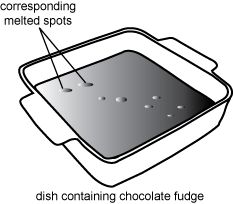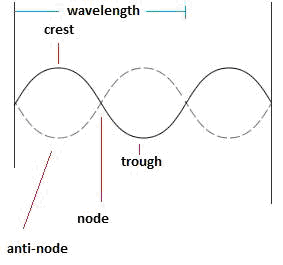Students measure the frequency of the waves generated in a microwave oven using the following procedure. They place a large dish covered with a thin layer of chocolate fudge inside the microwave oven and turn on the oven for about 40 seconds, making certain that the dish does not rotate. When they remove the dish, they observe several melted spots on the fudge, as shown in the diagram below. The students measure the distance, d, between corresponding melted spots and find the average to be about d = 6.0 cmd equals 6.0 cm.

There are bubbles on the surface of the fudge. They appear mostly in pairs in a diagonal line from one side of the pan to the other. One pair is labeled corresponding melted spots.
The students next argue that the distance between the corresponding melted spots represents one-half the wavelength of the microwaves and use the formula c = f λ, with λ = 2d = 12.0 cmc equals f lambda, with lambda equals 2d equals 12.0 cm and c the speed of a microwave, to solve for f, the frequency of the waves.
Which of the following best justifies the assumption that λ = 2dlambda equals 2d?
- d represents the average value of the microwave amplitudes.
- d represents the distance between a crest and a trough of a standing wave.
- d represents the angle of refraction of the microwaves passing through the fudge.
- d represents the average speed of the waves times the wave period.
Correct Response and Explanation (Show Correct ResponseHide Correct Response)
B. This question requires the examinee to analyze the properties of waves (e.g., speed, frequency, wavelength). A microwave oven generates electromagnetic waves. Electromagnetic waves, like all waves, obey the superposition principle, which states that two or more electromagnetic waves can be combined together to create a resultant wave. The waves may add (if they are in phase) or subtract (if they are out of phase). Microwave ovens are designed so that the electromagnetic waves confined in the space inside the microwave oven reflect off the walls and recombine in such a way as to produce a standing wave (also called a stationary wave). This phenomenon is identical to that of a wave on a plucked string that is fixed at both ends, such as on a guitar string. The diagram below represents the nodes and antinodes of a standing electromagnetic wave. The nodes of a standing wave are where the reflected waves subtract and the wave amplitude is zero. The antinodes are where the reflected waves add together to create a maximum amplitude. At the antinodes, the electric field associated with the wave will transmit the maximum amount of energy to the water molecules in the fudge, causing them to gain molecular motion and increase in temperature, melting the fudge. Therefore, if the melted regions are formed by the antinodes of the standing waves, then they correspond to the crest and trough of a standing wave. As can be seen in the diagram, if L represents the wavelength of the standing wave, then the distance between the melted regions should be one-half of the wavelength, or L = 2dL equals 2d, which justifies the assumption made by the students.

Additional labels identify the high point as the crest and the low point as the trough. An additional wave is shown by a dashed line, offset by half a wavelength. The point where the first wave's crest and additional wave's trough align is labeled anti-node, and the point where the two waves cross is labeled node.

